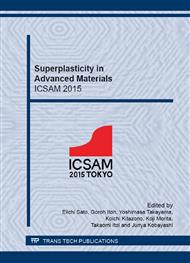[1]
V. Domnich, S. Reynaud, R. A. Haber, M. Chhowalla M, Boron carbide: structure, properties and stability under stress, J Am Ceram Soc, 94 (2011) 3605-3628.
DOI: 10.1111/j.1551-2916.2011.04865.x
Google Scholar
[2]
F. Thévenot , Boron carbide-a comprehensive review, J Eur Ceram Soc, 6 (1990) 205-225.
Google Scholar
[3]
A. K. Suri, C. Subramanian, J. K. Sonber, T. S. Murthy, Synthesis and consolidation of boron carbide: a review, Int. Mat. Rev, 55 (2010) 4-40.
DOI: 10.1179/095066009x12506721665211
Google Scholar
[4]
S. Hayun, V. Paris, M. P. Dariel, N. Frage, E. Zaretzky, Static and dynamic mechanical properties of boron carbide prepared by spark plasma sintering, J Eur Ceram Soc, 29 (2009) 3395-3400.
DOI: 10.1016/j.jeurceramsoc.2009.07.007
Google Scholar
[5]
D. Ghosh, G. Subhash, T. S. Sudarshan, R. Radhakrishnan, X. L. Gao, Dynamic indentation response of fine-grained boron carbide, J Am Ceram Soc, 90 (2007)1850-1857.
DOI: 10.1111/j.1551-2916.2007.01652.x
Google Scholar
[6]
B. M. Moshtaghioun, F. L. Cumbrera-Hernández, D. Gómez-García, S. de Bernardi-Martín, A. Domínguez-Rodríguez A, Monshi, M. H. Abbasi, Effect of spark plasma sintering parameters on microstructure and room-temperature hardness and toughness of fine-grained boron carbide (B4C), J. Eur. Ceram. Soc, 33 (2013).
DOI: 10.1016/j.jeurceramsoc.2012.08.028
Google Scholar
[7]
K. Madhav Reddy, J. J. Gua, Y. Shinoda, T. Fujita, A. Hirata, J. P. Singh, J. M. McCauley, and M. W. Chen. Enhanced mechanical properties of nanocrystalline boron carbide by nanoporosity and interface phases. Nat. Commun. 3: 1052 doi: 10. 1038/ncomms2047 (2012).
DOI: 10.1038/ncomms2047
Google Scholar
[8]
M. W. Chen, , J. W. McCauley, & K. J. Hemker. Shock-induced localized amorphization in boron carbide. Science 299, ( 2003) 1563–1566.
DOI: 10.1126/science.1080819
Google Scholar
[9]
I. Bogomol, T. Nishimura, O. Vasylkiv, Y. Sakka, P. Lobodo P, Microstructure and high-temperature strength of B4C-TiB2 composite prepared by a crucibleless zone melting method, J. Alloys and Comp. 485 (2009), 677-681.
DOI: 10.1016/j.jallcom.2009.06.044
Google Scholar
[10]
S. Yamada, K. Hirao, Y. Yamaguchi, S. Kanzaki, High strength B4C-TiB2 composites fabricated by reaction hot-pressing, J. Eur. Ceram. Soc. 23 (2003) 313-318.
DOI: 10.1016/s0955-2219(02)00274-1
Google Scholar
[11]
T. G. Abzianidze, A. M. Eristavi, S. O. Shalamberidze, Strength and creep in boron carbide (B4C) and aluminium dodecaboride (aAlB12), J. Solid State Chem, 154 (2000) 191-193.
DOI: 10.1006/jssc.2000.8834
Google Scholar
[12]
B. M. Moshtaghioun, D. Gómez-García, A. Domínguez-Rodríguez, N. P. Padture., High-temperature creep deformation of coarse-grained boron carbide ceramics, J. Eur. Ceram. Soc, 35 (2015) 1423-1429.
DOI: 10.1016/j.jeurceramsoc.2014.11.001
Google Scholar
[13]
D. Gomez-Garcia, J. Martinez-Fernandez., A. Dominguez-Rodriguez, P. Eveno , J. Castaing, Deformation mechanisms for high-temperature creep of high yttria content stabilized zirconia single crystals. Acta. Mater. 44, (1996) 991-999.
DOI: 10.1016/1359-6454(95)00254-5
Google Scholar
[14]
J. E. Dorn, Some fundamental experiments on high temperature creep. J. Mech. Phys. Solids. 8 (1954) 85-116.
Google Scholar


